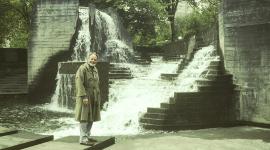Shlomo Aronson Reminisces About Lawrence Halprin
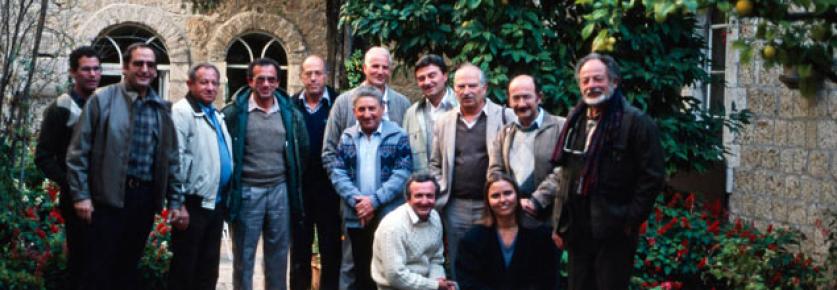
Early Life
Larry Halprin was born in one of the bloodiest periods of human history, at the end of the First World War. This was a period, between the World Wars, when many people in the West were uncompromisingly committed to the then-current ideological camps. Socialism, Communism, and Fascism were political ideologies competing with indigenous economic capitalism during Halprin’s youth.
After graduating from high school in the summer of 1933, Larry went to live in what was then Palestine. He worked at several jobs in different parts of the country and was among the founders of Kibbutz Ein Hashofet, where he lived for almost a year. He was much influenced by the people of the kibbutz who were full of enthusiasm about the new society that they were struggling to create. He relished the intensity and vigor of the “kibbutzniks,” and always felt that his time in Ein Hashofet was a formative, positive period in his life. At times, he criticized Israel, but he loved it. In almost all of his trips to Israel he would try to squeeze in a visit to the Kibbutz.
His mother, who was a central personality in American Jewry through her involvement in the Hadassah Women’s Organization (and the head of the organization for decades) even though she was a great Zionist, wouldn’t even hear about Larry remaining in a kibbutz.
Eventually her strong character prevailed and, in 1935, Larry left the kibbutz and returned to the United States to study. In spite of this, he did go through the experience of war. He later joined the United States Navy and was an officer on a ship which was hit by a Japanese Kamikaze during the Second World War. This was an experience which also left a strong mark on him. He often talked about these experiences.
Larry loved nature and that is one of the most important elements in both his personal and professional life. It is interesting to note how he chose to draw trees; very similar in all his sketches. There is something in the character of his trees, like that of a nice old uncle, very encouraging. You can see the love of nature in the smile of his sketches, in their personality, self-satisfaction with humor.
While searching for direction, Larry stumbled by chance on a small brochure by Christopher Tunnard that changed his life. He found in this short writing the answer to his search for a vocation: Landscape Architecture. He never regretted it.*
The Jerusalem Committee
Larry’s influence in Jerusalem, or even in Israel, relates to what I consider his most central contribution to Israel: his participation in The Jerusalem Committee. After the Six Days War when Jerusalem became a united city again, there was a need to create a workable entity of it. A new radical plan was called for to integrate the different sets of infrastructures such as transportation, water, electricity, housing, etc.
As it happened, Jerusalem had embarked in the late 1960s on the process of creating a new master plan and it was, at the time of the war, in the approval stage. The Master Plan was headed by the team of Avia and Zion Hashimshoni and Yosef Schweid. The plan had some very important positive points, mainly regarding the open space pattern. But it was weak and not very imaginative regarding transportation and would have endangered historical Jerusalem. Jerusalem’s Mayor, Teddy Kollek, wisely wanted to take advantage of the advice of the members of the Jerusalem Committee whom he had invited to give their input to development in Jerusalem, but he didn’t realize the depth of the criticism that would be forthcoming.
There was a constellation of world famous intellectuals, architects and designers on the committee along with Larry, including Lewis Mumford, Buckminster Fuller, Denys Lasdun, Nikolaus Pevsner, Philip Johnson, Louis Kahn, Isamu Noguchi, Bruno Zevi, Moshe Safdie, and some leading Israeli planners. Larry, along with many others, immediately saw very serious deficiencies in the 1968 plan. With his knowledge of projects with similar problems such as the “Pan Handle Freeway” in San Francisco which was eventually cancelled, he advocated redoing the whole plan from the beginning.
At that late time in the course of the planning process, there was every reason not to go back to start again. The loud and clear voices of the critics of the plan won the day. Larry, by adding his strong voice to the criticism, contributed to bringing this about. Larry was a gifted communicator with powerful convictions and he enjoyed the fight for what he believed in.
In response,Teddy Kollek, after serious deliberation, announced a halt of the almost-finished Jerusalem Master Plan and the beginning of a rethink of the whole thing. The major lesson from this episode is that suddenly it looked so possible to do it better. The plan could and should be changed because the essence of Jerusalem carried deep historical value. In such a case, as with physicians of the human body, planners should strive to do no harm. Because of this episode, the Jerusalem city planners became much more aware of the sanctity of this special city, and the fact that development and planning here (and anywhere) deserves the utmost care.
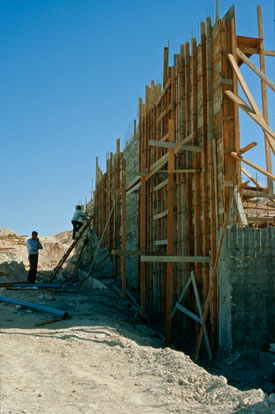
Hass Promenade Scaffolding
The Jerusalem Promenade and Park
During this time, Larry and I became involved in a project which was to have very important meaning for Jerusalem. As in many professions, a good project usually also includes a lot of luck. The Jerusalem Promenade and Park, on which I worked both with Larry and independently, is a good example. The area of the slopes descending from the crest of the United Nations Headquarters to Jerusalem has an outstanding and unique view looking to the Temple Mount and the Judean Desert, a world-class panorama full of meaning for millions. The land in this area was understood to be prime real estate, and there had been many suggestions over time to make use of its intrinsic value by building expensive properties, including locating the foreign embassies there. Fortunately, a number of influential people in the Land Authority of Israel, the Jerusalem Municipality, and the Jerusalem Foundation agreed to keep this land open for public enjoyment. This moment of grace enabled local bureaucratic approval to be quickly given, donors to realize the value and importance of a public project in this area, and the work to begin.
National Master Plan
One of the most important goals in landscape planning is to achieve an open-ended plan. By open-ended I mean a plan that can grow and redirect itself both in a geographical sense (expansion) and in time (future change). An open-ended landscape plan strives to incorporate a system of plant material that can also extend through space and time. Thus, the great investment in time and resources of a master plan will be justified, preserved, and enhanced.
In the early 1990s, the Israeli Ministry of Interior commissioned a master plan for the whole country. Shamai Assif was the head of the National Master Plan team of which I was the Landscape Architect. Our role in developing this Master Plan was in two major things: the locations and characteristics of the open spaces and the visual aspect of the design. Landscape Architecture has evolved over the last 45 years to be an essential and integral part of a sophisticated planning structure in Israel. It is recognized as being a major contributor to a positive outcome for an increasingly complicated region.
Much of my work in very big projects, including the National Master Plan, was influenced by seeing Larry’s approach and the depth of his understanding, and knowing, from his experience, that things can be changed for the better. This gave me the courage to take on such large and complicated projects and to think big.
Later Years
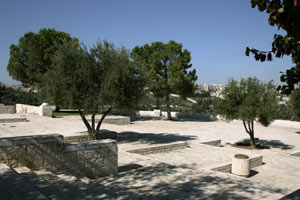
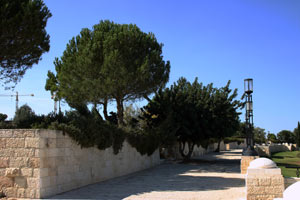
Haas Promenade
During the 1970s, there was a sort of revolution in Larry’s office about the running of the office, the distribution of fees, administrative decisions, etc. It had the overtones of a fight of the young guard, the revolutionaries, against the establishment. Suddenly Larry found himself forced into the role of the entrenched establishment defending against energetic youth. He was outraged. He saw this development as a personal betrayal by his ex-partners. He ended up closing the office and withdrawing to a much smaller enterprise. Looking back at the subsequent period, one can say that he lost some of the happiness and strength which he had in the 1960s when he was leading and growing his practice by the force and undoubted charm of his personality. This internal revolution was felt as a personal betrayal.
His talent and character carried him past this time to accomplish many more outstanding works, such as the Haas Promenade in Jerusalem; the Franklin Delano Roosevelt Memorial in Washington, D.C.; the FIAT plant in Florence, Italy; and Levi’s Plaza and Embarcadero Fountain, both in San Francisco. I was lucky to have learned through working with him in the golden age of his career, the early ‘60s when he was doing projects like Sea Ranch, the Portland fountain, Ghirardelli Square, Nicolet Avenue and many more.
Larry, always like a cat falling on its feet, made brilliant presentations, whether planned or extemporaneous. He was a concise and entertaining speaker. I remember how he went to Eilat on the Red Sea for a project that was offered to him by the Shoyer family of New York. He made a presentation about Eilat on the spot, with no previous preparation, to a gathering of the Mayor and the City Council and other local dignitaries. You could see that he enjoyed speaking in such a situation, putting things together, making sense of the existing situation, and projecting his ideas toward a solution for the future. He was very convincing.
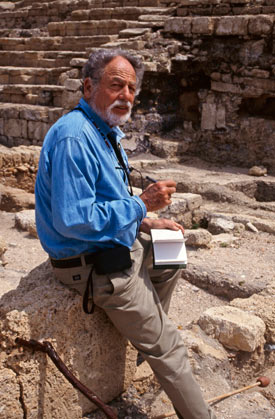
Halprin at Caeseria, 1998.Larry was also a strong man physically. I took him once on a long hiking trip in the Judean Desert to the project of the Conveyor Belt (an eighteen-kilometer-long system of bridges to haul the potash from the Dead Sea to Arad in the Judean Desert). The track is very, very difficult. Larry, at that time in his 70s, walked superbly, didn’t complain, and enjoyed the duration of the hike.
Larry loved to stay in the American Colony Hotel in Jerusalem. He knew the original family who owned the hotel. He made friends with many of the remarkable guests who came and went. The courtyard cafe at the American Colony was (and still is) like a movie set where one might bump into celebrities such as Peter Ustinov, as well as first string foreign correspondents from all over the world. Larry loved Dry Martinis, a habit going back to his years at 1620 Montgomery Street. Larry had a quick, sharp sense of humor and he could see in any situation the funny part.
Larry’s Influence on Me
I got to know Larry more closely in my senior year as a student when he was teaching the design class in Landscape Architecture at UC Berkeley. One of his assignments was to study the city and to express it graphically and in other ways. I suggested that instead of each student choosing his own media which would result in many small projects with nothing holding them together, rather we could photograph elements from the city and put them together to make a big “happening” using slides, black and white photographs, sound recordings, and drawings. Larry liked this idea, and he asked me to organize it. We all had a great time collecting our materials which were organized under my direction. Toward the end of the semester, he invited to the presentation—the happening—many of his professional friends and acquaintances, all the students, as well as other students in related fields. It was to be held in the basement of his office in San Francisco late one day. Everything was going well until an overload on the electrical system shorted out the power. We tried to get the electricity up again but, it already being quite late, most of the guests had left before we finally got the show going. In the end some twenty people remained and the presentation was, indeed, very exciting.
After graduating with a Bachelor of Landscape Architecture from Berkeley, I went to work for Larry in his San Francisco office where I stayed for a year and a half. Subsequently, with Larry’s recommendation and encouragement, I went to Harvard University Graduate School of Design for my Master of Architecture.
I discovered quite early that a good, clever idea can lift you above a great deal of ordinary work, save a lot of time, and make a success out of the effort. At Harvard, I took all the History of Architecture courses, and finally came to a true understanding of what Architecture really is. This very broad understanding came only at the end of my education, only with the eye-opening courses of Eduard Seckler, James Ackerman, and Jerzy Soltan.
After the 1967 War, having lived abroad for seven years, I opened an office in Jerusalem. The awareness of the need for large-scale professional landscape work was just coming into focus with the responsible government agencies. I was overwhelmed with the importance and size of the jobs and the basic need for landscape design.
As one of the first landscape professionals in the country, I did every kind of job. The awareness of the outdoors is quite deep in Israel in modern times, but no traditional or systematic analytical approach was used in design, not in Israel but also not in America or Europe at that time. There was almost nothing in Israel to fertilize my ideas of place.
I was fortunate enough to be able to have a very rich practice in Israel, a practice which doesn’t repeat itself or specialize in a narrow part of the field. I had more interest and more fun in a practice with a broad outlook toward my profession. Last year I retired from active involvement in the office, which is now run by my son and daughter-in-law. We continue to enjoy and have fun practicing this great profession. In the last years, I have written three books, the last of which, ARIDSCAPES, was published in 2008.
*A similar series of events happened to me. I studied architecture at UC Berkeley. In the fourth semester I took a required course which explained, by different practitioners, the professions that relate to architecture. This course took place at 8am and many times the students were quite tired. I remember the room with beautiful colored slides from two sources. The practitioner explaining Landscape Architecture was Lawrence Halprin. The projects which he showed us were his newest work on private residences and a shopping center, but for me it was like seeing the Promised Land. Until then I had never heard of this profession, but this was what I really wanted to do. When class was over I went and talked to the lecturer, Larry, and he encouraged my instant decision to change majors from Architecture to Landscape Architecture. He told me then about his experience on the Kibbutz and that he believed Israel needed people with this expertise. By the end of the week, I was studying Landscape Architecture.
All Images courtesy the author.




